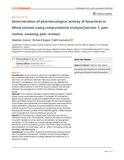Determination of pharmacological activity of bioactives in Allium sativum using computational analysis
Abstract
Introduction: Use of natural products for management of diseases
has increased widely due to the belief that natural products are less
toxic than conventional medicines. Natural products have been
utilised for management of chronic diseases such as diabetes and
cancers. Respiratory infections have also been managed using natural
products. Allium sativum is one of the natural products that has been
utilised in the management of SARS-CoV infections, diabetes and
cancer.
Methods: This study was aimed at screening bioactive agents in Allium
sativum using computational analysis. The targets of the bioactive
agents were predicted using SwissTargetPrediction tools. Molecular
docking followed, where the docking energies of the bioactive agents
to the targets were generated. The bioactive agents were analysed for
pharmacokinetics properties using SwissADME as well as toxicity
profiles using the ProTox II webserver. The docking scores, toxicities
and pharmacokinetics profiles of the bioactive agents in Allium sativum
were compared with those of reference compounds.
Results: All the bioactives showed lower docking scores than the
reference compounds. The bioactives, however, showed some activity
on specific receptors such as carbonic anhydrases, cyclooxygenase
and ghrelin. All the bioactives showed high gastrointestinal tract
absorption and none violated Lipinski’s rule of five. Diallyl trisulphide
was predicted to be most lethal, with an LD50 of 100mg/kg, while was
the safest, with 8000mg/kg.
Conclusions: In conclusion, bioactives showed lower docking scores
than the reference compounds, therefore overall pharmacological
activity could be attributed to synergy between the bioactives for a
particular receptor.

